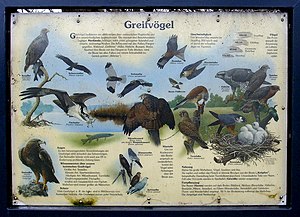Birds of prey
| Birds of prey | ||||||||||||
|---|---|---|---|---|---|---|---|---|---|---|---|---|

Reaching osprey ( Pandion haliaetus ) in Mecklenburg |
||||||||||||
| Systematics | ||||||||||||
|
||||||||||||
| Scientific name | ||||||||||||
| Accipitriformes | ||||||||||||
| Vieillot , 1816 |
The birds of prey (Accipitriformes) are an order of largely carnivorous birds. It includes the hawk-like (Accipitridae) as well as the osprey , the secretary and the New World vulture (Cathartidae).
Classification
According to the earlier classification, the birds of prey also included the hawk-like and were named after them, Falconiformes. However, molecular genetic studies in the 21st century made it clear that the falcons are not closely related to the other families of traditional birds of prey, but rather that they are closest to the parrots and passerines . The strong external similarities between the birds of prey and the hawk-like are therefore a result of convergent evolution .
History and extent of the taxon
Originally, the animals later referred to as birds of prey were grouped together with the owls in the order birds of prey , although the owls were recognized as not closely related to the others as early as the late 19th century.
The position of the New World vultures , which were at times also included with the storks , has always been controversial . According to current opinion, however, they actually belong to the birds of prey and form the sister taxon of all the others, i.e. the families Accipitridae (hawks and sparrowhawks), Pandionidae (osprey) and Sagittariidae (secretary).
In molecular genetic studies in the 21st century, the falconies turned out to be not closely related to the other families that were previously included in this order, but only developed similar characteristics through convergent evolution . In fact, they are the sister taxon of a large group that includes the parrot birds ( Psittaciformes) and the passerine birds (Passeriformes). This means that falcons are not among the birds of prey.
Such a hypothesis, based on molecular genetic data, of the relationships between birds shows the following relationships within birds of prey:
| Birds of prey (Accipitriformes) |
|
||||||||||||||||||
|
|
According to these hypotheses, the immediate relationship ( sister group ) of the birds of prey consists of a diverse grouping of land birds, including the owlbirds (Strigiformes), hornbill-like (Bucerotiformes), woodpecker-like and whackebirds (Coraciiformes), and with which they form a clade, which is called Afroaves .
Naturally, the relationship between recent birds of prey and fossil groups cannot be determined using molecular genetic data. Due to morphological characteristics, the large Teratornithidae (Upper Oligocene to Pleistocene ) from North and South America are often considered to be the sister group of the New World vultures and thus as extinct representatives of the raptor crown group .
literature
- Shannon J. Hackett, RT Kimball, S. Reddy, RCK Bowie, EL Braun, MJ Braun, JL Chojnowski, WA Cox, K.-L. Han, J. Harshman, C. Huddleston, BD Marks, KJ Miglia, WS Moore, FH Sheldon, DW Steadman, CC Witt, and T. Yuri: A Phylogenomic Study of Birds Reveals Their Evolutionary History. Science. Vol. 320 (No. 5884), 2008, pp. 1763–1768 doi: 10.1126 / science.1157704 .
Web links
Individual evidence
- ↑ International Ornithologist's Union: IOC World Bird List, version 2.5 - Raptors. Online , accessed on June 19, 2016. (Complete list as Excel file )
- ↑ Excerpt from the result of a comprehensive analysis based on nuclear DNA with 169 species representing all important recent groups of birds, see: Shannon J. Hackett, Rebecca T. Kimball, Sushma Reddy and 15 other authors: A phylogenomic study of birds reveals their evolutionary history. Science. Vol. 320, No. 5884, 2008, pp. 1763-1768, doi: 10.1126 / science.1157704 .
- ^ Name of the taxa according to John Harshman: Accipitriformes . Version dated June 27, 2008. The Tree of Life Web Project
- ↑ Hackett et al .: A Phylogenomic Study of Birds ... 2008 (see above in the individual reference list and literature )
- ↑ a b Erich D. Jarvis, Siavash Mirarab, Andre J. Aberer and approx. 90 other authors: Whole-genome analyzes resolve early branches in the tree of life of modern birds. Science. Vol. 346, No. 6215, 2014, pp. 1320–1331, doi: 10.1126 / science.1253451 .
- ↑ Gerald Mayr: Paleogene Fossil Birds. Springer, 2009, ISBN 978-3-540-89627-2 , p. 156 f.
- ↑ Gerald Mayr: Avian Evolution: The Fossil Record of Birds and Its Paleobiological Significance. Wiley-Blackwell, 2017, ISBN 978-1-119-02076-9 , pp. 199 f.
